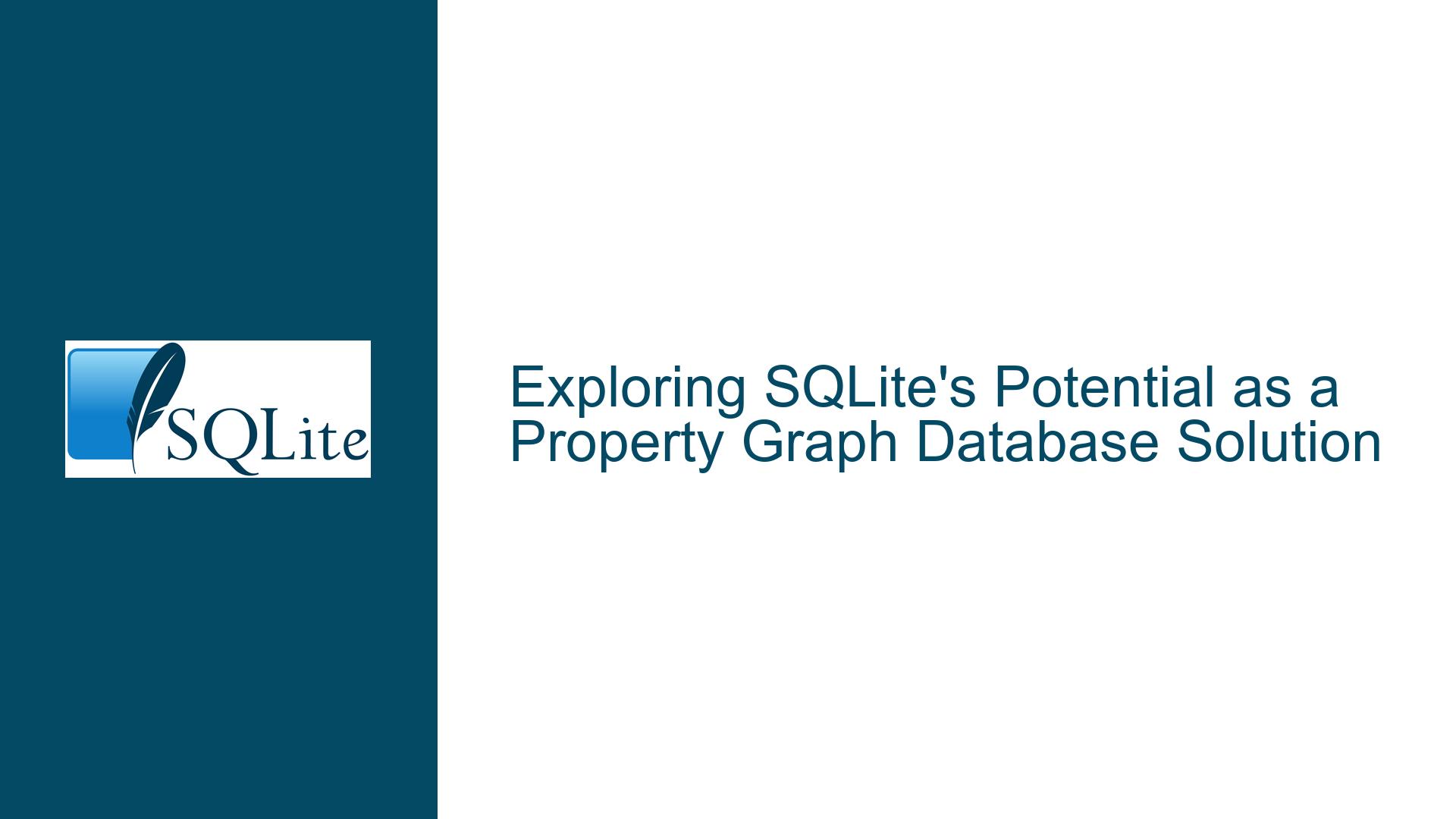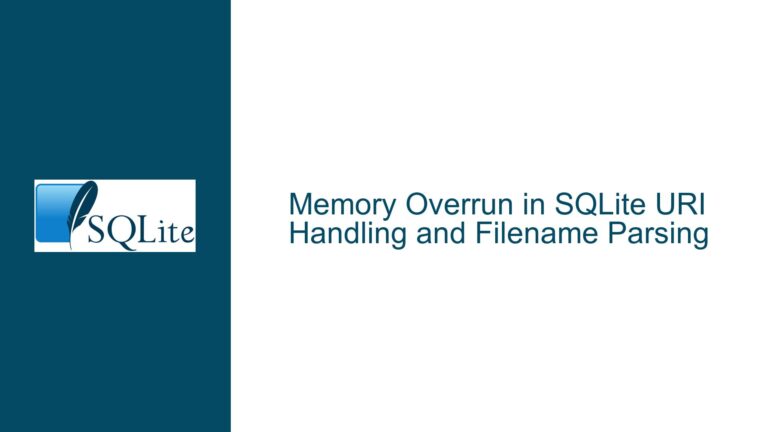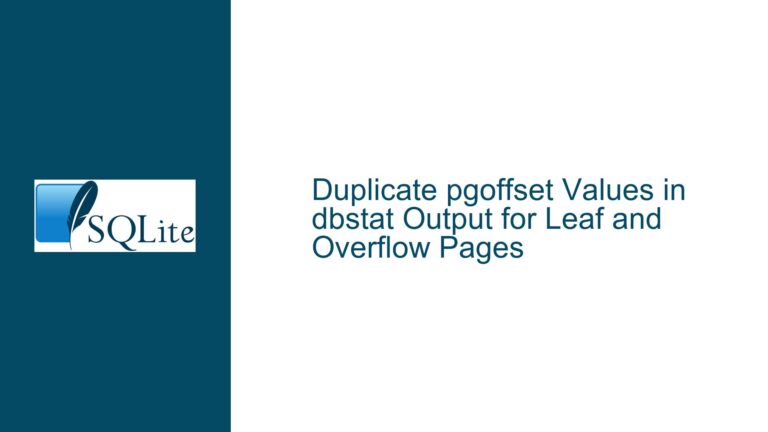Exploring SQLite’s Potential as a Property Graph Database Solution
Property Graph Database Requirements vs. SQLite’s Relational Foundation
Issue Overview
The core issue revolves around whether SQLite’s architecture and design philosophy can support a property graph database model. Property graph databases, such as Neo4j and Memgraph, emphasize nodes, edges, and properties as first-class citizens, enabling intuitive representation of complex relationships and graph traversals. These systems prioritize schema flexibility, path-based querying (e.g., Cypher or GQL), and efficient traversal of interconnected data. SQLite, by contrast, is a relational database engine optimized for tabular data storage, ACID compliance, and SQL semantics. The discussion highlights a growing interest in bridging these paradigms—leveraging SQLite’s reliability and lightweight footprint to support graph-like queries while retaining its relational underpinnings.
A property graph database requires three foundational components:
- Nodes: Entities with labels (e.g.,
Person,Product) and key-value properties. - Edges: Directed relationships between nodes, often with their own labels (e.g.,
FRIEND_OF,PURCHASED) and properties. - Traversal Optimizations: Efficient algorithms for navigating paths (e.g., shortest path, pattern matching) without requiring complex joins or recursive CTEs.
SQLite’s relational model inherently lacks native support for these constructs. Tables can approximate nodes and edges, but properties are stored in rigid columns, and relationships require foreign keys or junction tables. Queries involving multi-hop traversals (e.g., "Find all friends of friends") demand recursive common table expressions (CTEs) or nested joins, which are computationally expensive compared to graph-native index-free adjacency.
The challenge lies in reconciling SQLite’s simplicity with the dynamic, schema-agnostic nature of property graphs. For instance, adding a new property to a node in a graph database requires no schema changes, whereas SQLite would necessitate an ALTER TABLE statement or an entity-attribute-value (EAV) table—a pattern notorious for performance issues. Additionally, graph query languages like Cypher or GQL introduce syntax and semantics foreign to SQL, such as pattern matching ((a:Person)-[:FRIEND_OF]->(b:Person)), which SQL engines struggle to optimize.
Proponents of integrating graph capabilities into SQLite argue that its extensibility (via virtual tables, loadable extensions, and the JSON1 module) provides a pathway to emulate graph-like behavior. However, this approach risks compromising SQLite’s hallmark strengths: minimal setup, portability, and deterministic performance.
Technical and Conceptual Barriers to Graph-Relational Integration
Possible Causes
Schema Rigidity vs. Graph Flexibility:
SQLite enforces a strict schema-on-write model. Columns must be predefined, and type affinity is determined at table creation. Property graphs, conversely, allow schema-on-read, where nodes and edges can have arbitrary properties. Translating this flexibility into SQLite’s relational framework requires either:- Wide Tables with Sparse Columns: Storing all possible properties as columns, leading to table bloat and NULL-heavy rows.
- Entity-Attribute-Value (EAV) Patterns: Using separate tables for entities, attributes, and values. This introduces JOIN complexity and degrades query performance.
- JSON-Based Property Storage: Leveraging SQLite’s JSON1 extension to store properties as JSON objects. While flexible, this sacrifices type safety and complicates indexing.
Lack of Native Graph Traversal Operators:
Graph databases optimize for traversals using index-free adjacency—direct pointers between nodes and edges. SQLite lacks such structures. Recursive CTEs can simulate traversals but require the optimizer to unroll recursion into iterative steps, which is inefficient for deep or branching paths. For example, a query to find all friends within three degrees of separation in a social network would generate a combinatorial explosion of joins in SQLite, whereas a graph database uses pointer chasing for constant-time hops.Query Language Mismatch:
SQL is set-oriented and declarative but ill-suited for expressing graph patterns. Cypher’s ASCII-art syntax ((a)-[:KNOWS*1..3]->(b)) succinctly represents variable-length paths, but translating this into SQL requires elaborate subqueries and window functions. Projects like Microsoft’s openCypher-to-SQL transpiler demonstrate feasibility but face limitations:- Loss of Intent: Transpiled SQL queries may obscure the original graph semantics, making optimization harder.
- Performance Overheads: Generated SQL often relies on recursive CTEs or temporary tables, which SQLite may not execute efficiently.
Storage Engine Limitations:
SQLite’s B-tree-based storage engine excels at range queries and index lookups but lacks native support for graph-specific structures like adjacency lists with edge properties. Implementing such structures would require custom virtual tables or extensions, which bypass SQLite’s built-in query planner and optimizer.Transactional and Concurrency Constraints:
Graph databases often prioritize write-heavy workloads (e.g., adding edges in real-time social networks). SQLite’s write-ahead logging (WAL) mode supports concurrent readers but serializes writes. While adequate for embedded use cases, this could bottleneck high-throughput graph operations.
Strategies for Implementing Graph Queries Over SQLite
Troubleshooting Steps, Solutions & Fixes
1. Leveraging Existing Extensions and Transpilers
openCypher-to-SQL Transpilation:
Microsoft’s openCypher-to-SQL project demonstrates how Cypher queries can be translated into relational algebra. Adapting this to SQLite involves mapping Cypher clauses to SQLite-compatible constructs:- Pattern Matching: Convert edge patterns (
()-[:KNOWS]->()) into JOIN chains. - Variable-Length Paths: Use recursive CTEs with termination conditions.
- Property Access: Utilize JSON functions for dynamic properties.
Example translation:
MATCH (a:Person {name: 'Alice'})-[:FRIEND_OF*1..3]->(b:Person) RETURN b.nameBecomes:
WITH RECURSIVE friends AS ( SELECT 1 AS depth, nodes.id AS node_id, nodes.properties FROM nodes JOIN edges ON edges.source_id = nodes.id WHERE nodes.label = 'Person' AND json_extract(nodes.properties, '$.name') = 'Alice' AND edges.label = 'FRIEND_OF' UNION ALL SELECT depth + 1, edges.target_id, nodes.properties FROM friends JOIN edges ON edges.source_id = friends.node_id JOIN nodes ON nodes.id = edges.target_id WHERE edges.label = 'FRIEND_OF' AND depth < 3 ) SELECT json_extract(nodes.properties, '$.name') FROM friends JOIN nodes ON friends.node_id = nodes.id;Limitations include CTE performance and JSON parsing overhead.
- Pattern Matching: Convert edge patterns (
KuzuDB’s Embedded Approach:
KuzuDB is an embedded graph database that uses SQLite for storage but implements its own query engine. This hybrid model separates storage (SQLite tables) from processing (custom traversal logic). Developers can replicate this by:- Storing nodes and edges in SQLite tables with predefined schemas.
- Implementing graph algorithms (e.g., BFS, Dijkstra) as user-defined functions (UDFs).
- Using triggers to maintain graph invariants (e.g., edge consistency).
2. Schema Design Optimizations
Adjacency List Hybrid Model:
Combine relational and graph structures using optimized table designs:CREATE TABLE nodes ( id INTEGER PRIMARY KEY, label TEXT, properties TEXT -- JSON blob ); CREATE TABLE edges ( id INTEGER PRIMARY KEY, label TEXT, source_id INTEGER REFERENCES nodes(id), target_id INTEGER REFERENCES nodes(id), properties TEXT ); CREATE INDEX idx_edges_source ON edges(source_id); CREATE INDEX idx_edges_target ON edges(target_id);This allows efficient lookups by
source_idortarget_id, mimicking index-free adjacency.Materialized Path Views:
Precompute frequently accessed paths (e.g., organizational hierarchies) into materialized views:CREATE VIEW friend_paths AS WITH RECURSIVE paths AS ( SELECT source_id, target_id, 1 AS depth FROM edges WHERE label = 'FRIEND_OF' UNION ALL SELECT p.source_id, e.target_id, p.depth + 1 FROM paths p JOIN edges e ON p.target_id = e.source_id WHERE e.label = 'FRIEND_OF' AND depth < 3 ) SELECT * FROM paths;Refresh the view periodically or via triggers to balance freshness and performance.
3. Extending SQLite with Graph Primitives
Virtual Table Implementations:
Develop a custom virtual table module that exposes nodes and edges as virtual tables with graph-aware APIs. For example:CREATE VIRTUAL TABLE graph_nodes USING graph_module(label="Person"); CREATE VIRTUAL TABLE graph_edges USING graph_module(label="FRIEND_OF"); -- Query all friends of Alice SELECT target.properties FROM graph_edges WHERE source = (SELECT id FROM graph_nodes WHERE properties->>'name' = 'Alice');The virtual table would intercept these queries and use internal cursor implementations to traverse edges directly.
UDFs for Traversal and Analytics:
Extend SQLite with C/C++ UDFs for graph operations:#include <sqlite3ext.h> SQLITE_EXTENSION_INIT1 static void bfs(sqlite3_context *ctx, int argc, sqlite3_value **argv) { // Implement BFS traversal } int sqlite3_extension_init(sqlite3 *db, char **pzErrMsg, const sqlite3_api_routines *pApi) { SQLITE_EXTENSION_INIT2(pApi); sqlite3_create_function(db, "bfs", 2, SQLITE_UTF8, NULL, bfs, NULL, NULL); return SQLITE_OK; }Query usage:
SELECT bfs(start_node_id, max_depth) FROM nodes WHERE ...;
4. Hybrid Relational-Graph Workflows
Graph Caching Layers:
Use SQLite as the primary storage layer but cache hot graph segments in-memory using libraries like Redis or custom LRU caches. For example:- Query SQLite for a user’s immediate friends.
- Cache the friend list and their relationships in a graph structure.
- Serve subsequent traversals from the cache.
Batched Graph Processing:
Offload intensive graph computations (e.g., PageRank, community detection) to external systems using SQLite as a batch source:sqlite3 social.db "SELECT id, properties FROM nodes" > nodes.csv sqlite3 social.db "SELECT source_id, target_id FROM edges" > edges.csv neo4j-admin import --nodes=nodes.csv --relationships=edges.csv
5. Embracing Emerging Standards
GQL (Graph Query Language) Integration:
Monitor the ISO/IEC GQL standardization effort to align future extensions with industry practices. Prepare SQLite for GQL compatibility by:- Implementing GQL parsers as loadable extensions.
- Advocating for SQLite representation in the GQL working group.
Collaboration with Graph Projects:
Partner with initiatives like KuzuDB or EdgeDB to explore backend integrations. For instance, using SQLite as a storage engine for KuzuDB’s query executor.
6. Performance Mitigations
Partial Indexes for Graph Properties:
Create indexes on frequently queried properties to accelerate node/edge lookups:CREATE INDEX idx_person_name ON nodes(json_extract(properties, '$.name')) WHERE label = 'Person';Edge Partitioning:
Shard edges by label or source/target node ID to reduce scan overhead:CREATE TABLE edges_friend ( CHECK (label = 'FRIEND_OF') ) INHERITS (edges);Approximate Graph Metrics:
Use probabilistic data structures (HyperLogLog) or sampling to estimate graph metrics (e.g., node degrees, path counts) without full traversals.
Final Considerations
While SQLite is not inherently a graph database, its extensibility and reliability make it a viable foundation for graph-like applications through careful schema design, transpilation, and extensions. Developers must weigh the trade-offs between relational rigor and graph flexibility, opting for hybrid models where SQLite handles storage and simple queries, while external tools manage complex traversals. The emergence of GQL and transpilation technologies will further narrow the gap, but a native graph layer in SQLite would require significant architectural changes—an endeavor demanding community consensus and sustained development effort.






